Fact sheet: What are the gibbons? (original) (raw)
Thomas Geissmann
Anthropological Instiute
University Zürich-Irchel
Winterthurerstrasse 190
CH-8057 Zürich
Switzerland
E-mail: webmaster@gibbons.de
14 April 2005

| What are the gibbons? Gibbons are apes: The gibbons (family Hylobatidae) - together with the great apes (family Hominidae) - make up the superfamily of the apes (Hominoidea).The gibbons are also known as the small apes. With 12 species, the gibbons comprise the largest group of the apes. | 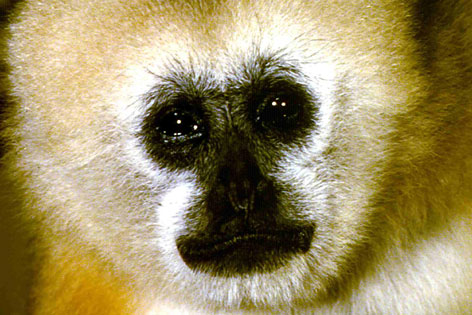 |
|---|---|
| Habitat adaptation The gibbons live in the evergreen tropical rainforests of Southeast Asia. They are adapted to life in the treetops. Gibbons eat mainly fruit - in addition, they eat leaves, flowers and insects. | 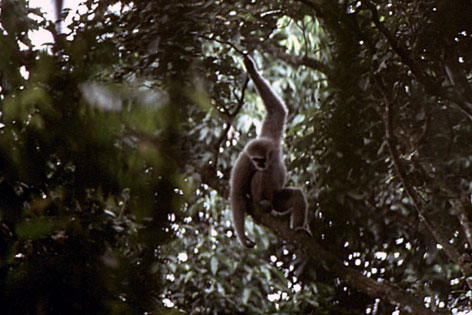 |
| Behaviour Gibbons live in small family groups (monogamy). The monogamous social structure is unusual - it occurs in only about 3% of mammals. Groups usually consist of an adult pair and their immature offspring. The group size is 2-6 individuals. Each group has a territory of 20-45 hectares, which is aggressively defended from other groups. Gibbon pair-bonds last for many years. | 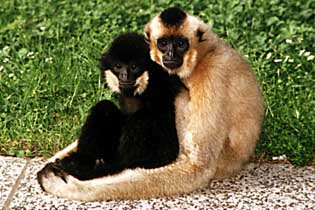 |
| Locomotion Gibbons move mainly by swinging by their arms (brachiation), but they can also walk on two legs (bipedalism). The spectacular brachiation of the gibbons makes them the most acrobatic of all apes. When in a hurry, gibbons seem to be virtually flying through the treetops. On branches and the ground, gibbons walk on two legs. Therefore, gibbons are possibly the best primate model for the evolution of bipedalism in humans. | 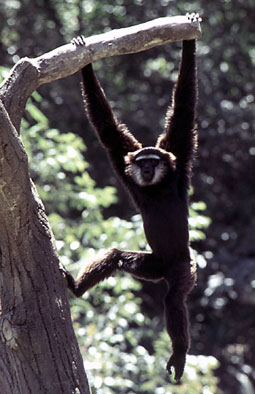 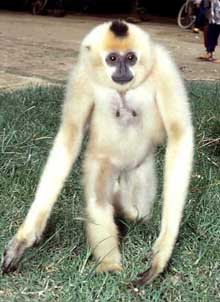 |
Anatomy Gibbons exhibit numerous anatomical specialisations which are linked to their unusual locomotion. For instance, their arms are particularly elongated. Relative to body size, gibbons have the longest arms of all primates. Gibbons weigh only 5-12 kg (there is variation between the species) and are therefore the smallest of the apes. Their light build makes enables them to collect fruit from thin branches. Like the other apes, gibbons do not have a tail.  Click here to see a short video clip of wild gibbons moving around in the tree crowns (Hylobates muelleri) (video: Yoichi Inoue). Click here to see a short video clip of wild gibbons moving around in the tree crowns (Hylobates muelleri) (video: Yoichi Inoue). |
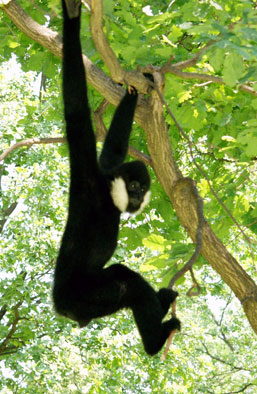 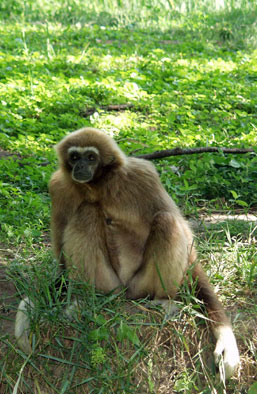 |
Systematics There are four main groups of gibbons. These are thought to represent different genera, which are as distant to each other as humans and chimpanzees. 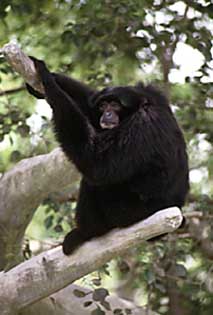 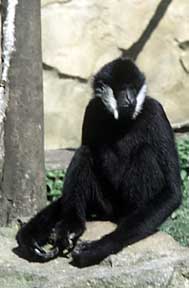   Siamangs Symphalangus 1 species Crested gibbons Nomascus 4 species Hoolocks Hoolock 1 species Lar or dwarf gibbons Hylobates 6 species Siamangs Symphalangus 1 species Crested gibbons Nomascus 4 species Hoolocks Hoolock 1 species Lar or dwarf gibbons Hylobates 6 species |
|
Distribution Gibbons have a large range that extends over almost all of Southeast Asia. Gibbons are distributed over most of Indo-Burma and Sundaland. These are two of earth's biologically richest and most endangered terrestrial ecoregions. 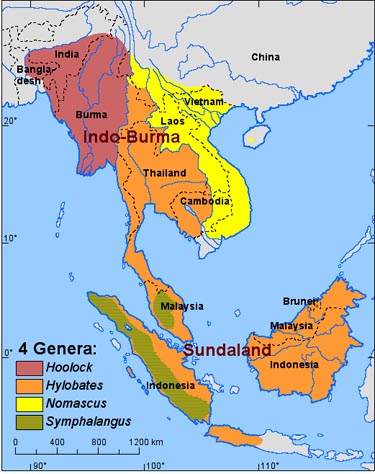 |
|
Gibbon songs Early in the morning, gibbons produce spectacular songs, which can be heard as far as 1-2 km away. Singing is very rare in mammals. Gibbons produce the most complex songs of all land mammals. Song-bouts usually last about 10-30 mins.Gibbon songs reveal the singer's species, sex and individual identity. The songs probably serve to mark territorial boundaries and find partners.  Click here to see a video excerpt from a male song of the white-cheeked crested gibbon (Nomascus leucogenys) (video: Thomas Geissmann). Click here to see a video excerpt from a male song of the white-cheeked crested gibbon (Nomascus leucogenys) (video: Thomas Geissmann). |
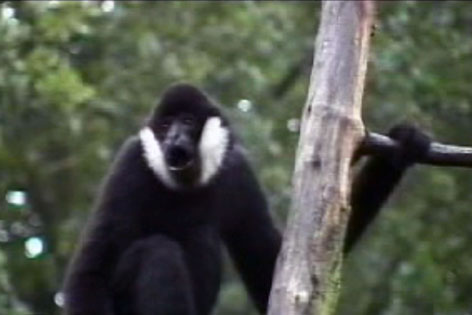 |
Duetting Mated gibbons usually sing together in well-coordinatedduets. Duetting probably serves to advertise or strengthen the pair bond. Gibbon songs are probably the best model for the evolution of human music, since both are derived from the same, genetically determined call type.  Click here to see a video excerpt from a duet song of the siamang (Symphalangus syndactylus) (video: Andrea About). Click here to see a video excerpt from a duet song of the siamang (Symphalangus syndactylus) (video: Andrea About). |
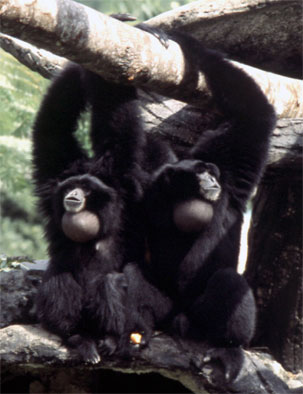 |
| Self recognition So far, the cognitive abilities of the gibbons have hardly been studied. Gibbons can recognise themselves in the mirror, which is generally taken to indicate self-consciousness. Gibbons share this ability only with humans and other great apes. Figure: This gibbon examines the inside of his mouth in the mirror (left) and makes unusual body positions (right). He is clearly interested in observing this in the reflection (photos: Maria Ujhelyi). Reference: Ujhelyi, M.; Merker, B.; Buk, P. and Geissmann, T. (2000) Journal of Comparative Psychology 114, pp. 253-262. | 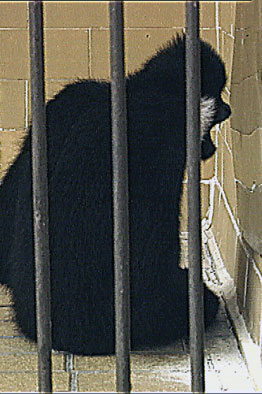 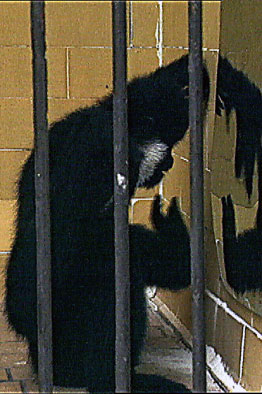 |
| Conservation Gibbons not only include the most endangered apes but also the most endangered primate species of the world. Several gibbon species are threatened by imminent extinction in the very near future. The plight of the small apes receives virtually no media coverage. The gibbons are the true neglected apes and need our help. Figure: Hunted pileated gibbon (Hylobates pileatus) in Cambodia (photo: Ian Baird). | 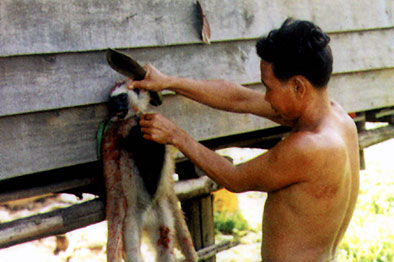 |
| Our knowledge Although the gibbons are the most species-rich group of the apes, so far they have been hardly studied. Gibbons are the most under-researched of the apes. We know nearly nothing about their social life and their cognitive capacities. Several species have never been studied in the wild, have never been filmed, and have never been bred in captivity. Gibbons are highly important in understanding the evolution of humans and apes. | 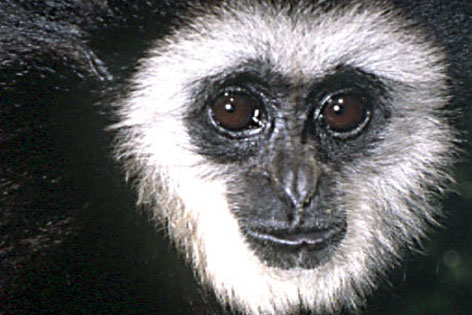 |
| Want to learn more? There is more on the Internet. Everything on gibbons: www.gibbons.de Conservation of the gibbons: www.gibbonconservation.org |   |
| Acknowledgements I thank Lucy Birkett for her help in translating this text. |